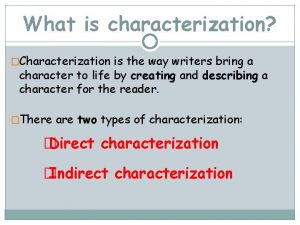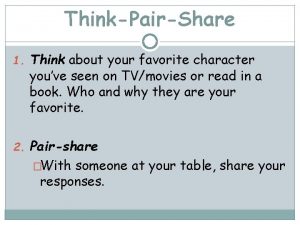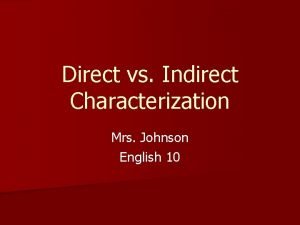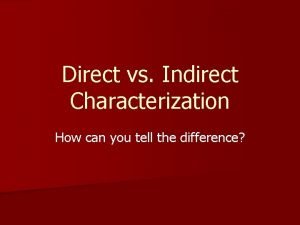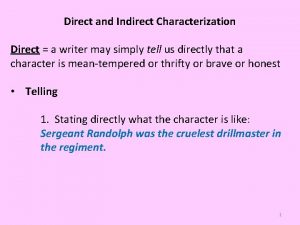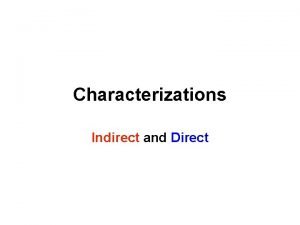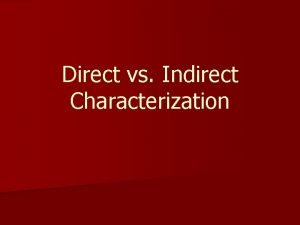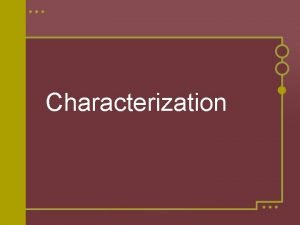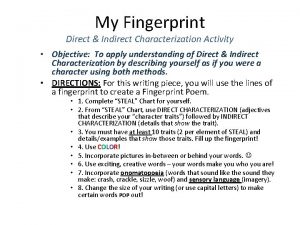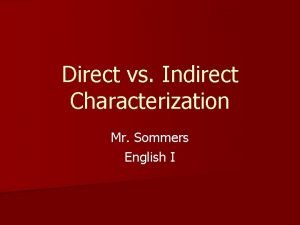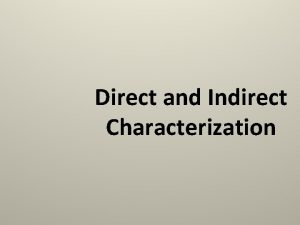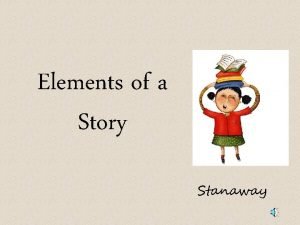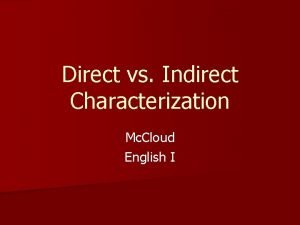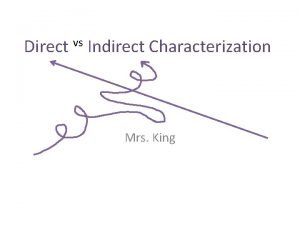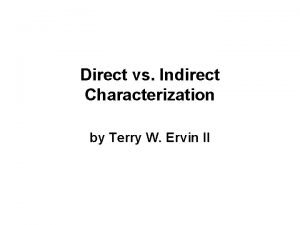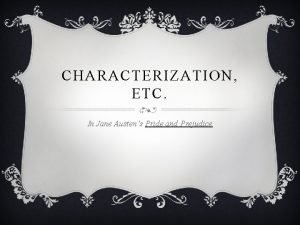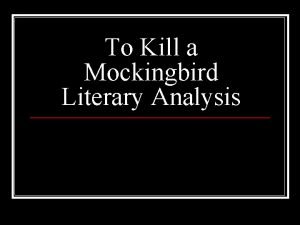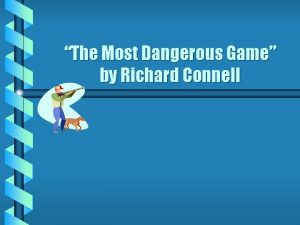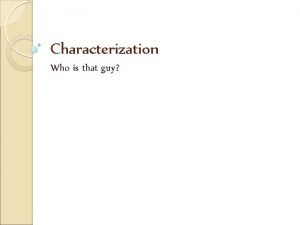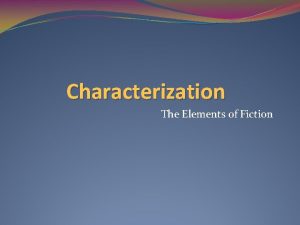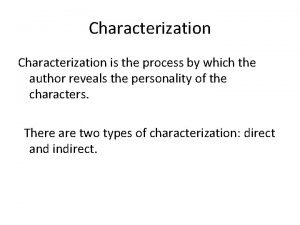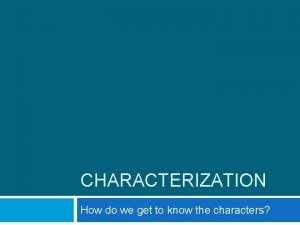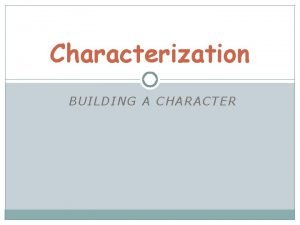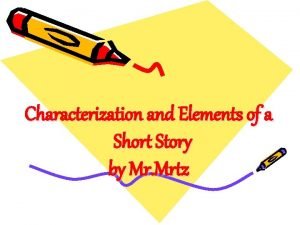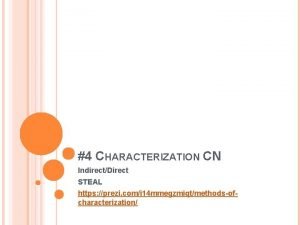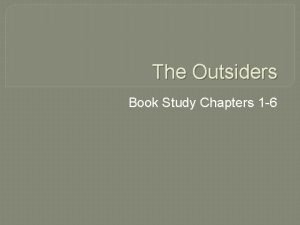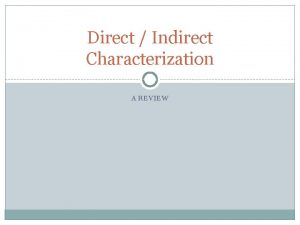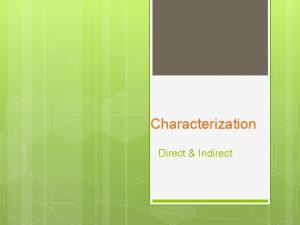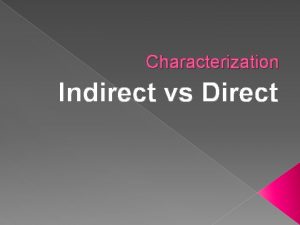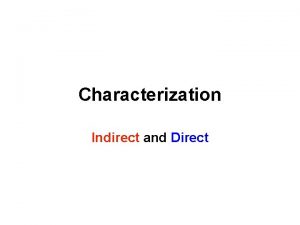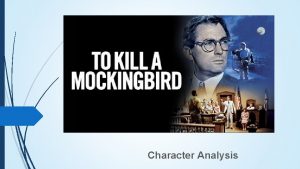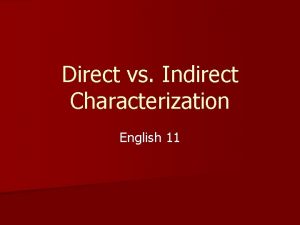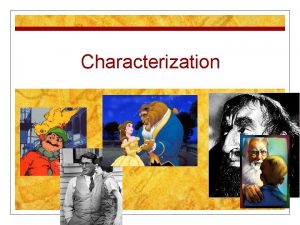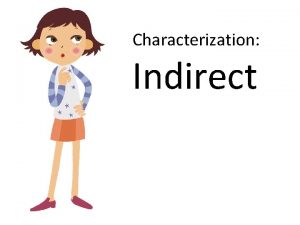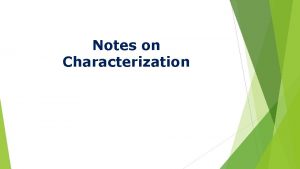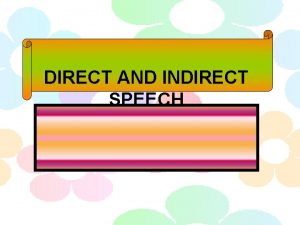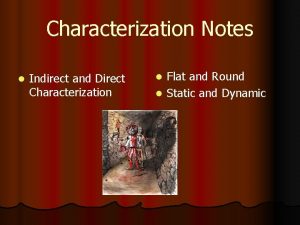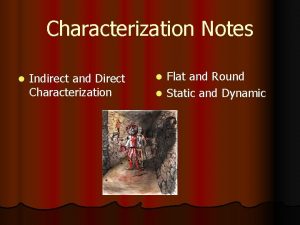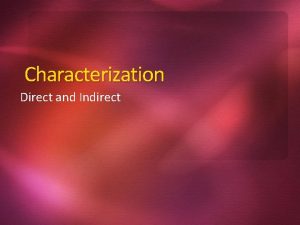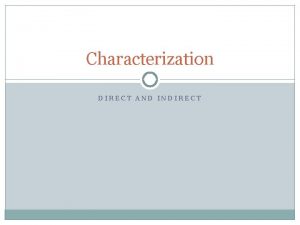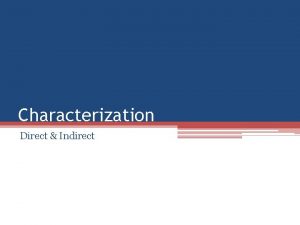Direct and Indirect Characterization Direct a writer may


































- Slides: 34

Direct and Indirect Characterization Direct = a writer may simply tell us directly that a character is mean-tempered or thrifty or brave or honest • Telling 1. Stating directly what the character is like: Sergeant Randolph was the cruelest drillmaster in the regiment. 1

Indirect = present day writers generally prefer to show their characters in action and let readers decide for themselves what kinds of people they are meeting • Showing 2. Describing the appearance of the character: The woman’s coat was gathered about her thin body and fastened with a safety pin. 3. Showing the character in action: Toni glanced around, then tossed her gum wrapper on the grass and kept walking. 4. Allowing the reader to hear the character speak: “I don’t have to do what you say, ” declared Darlene, glaring at the new baby-sitter. 5. Revealing the character’s thoughts and feelings: Tyler didn’t like the looks of the squash pudding but decided to eat some to please the cook. 6. Showing how others react to the character: “Team up with Erica? ” said Jorge. “Well, OK, if you can’t get anyone else. But when she was my partner before, I did all the work while she socialized. ” 2

Types of Indirect Characterization: • • • Speech Thoughts Effects on Others Actions Looks 3

Activity 1. Complete the characterization worksheet graphic to describe yourself using complete sentences and quotes when writing dialouge. 2. Meet with a partner and have the partner read the paragraph that you wrote about yourself. 3. Each of you will record on a T-chart the direct and indirect characterization that is identified in your partner’s paragraph. 4

Character Direct Characterization 5

Indirect Characterization Character’s Name Descriptions and Page numbers Speech Thoughts Effects on others Actions Looks 6

Types of Characters 7 Static - When people say that a character is "static, " they're referring to the fact that a character doesn't change. Example: Gale (Hunger Games) Dynamic – These characters will undergo some kind of change in the course of the story. Example: Haymitch Flat – These characters are minor characters in a work of fiction who do not undergo substantial change or growth in the course of a story. Example: President Snow Round - This is a major character in a work of fiction who encounters conflict and is changed by it. Round characters tend to be more fully developed Example: Ebenezer Scrooge, Katniss Everdeen 7

8 Textual Evidence from Story Exemplifying Four Types of Characters - Alfonso, Sondra, and Ernie Place the characters in the appropriate category of Static or Dynamic and Flat or Round. Explain using textual evidence to support your response. 8

9 Character’s Point of View “Broken Chain” Characters - Alfonso and Ernie Read the passage beginning with the first full paragraph/ the words “For the next hour” on page 33 through the paragraph ending with the words “might have found a girlfriend”. This passage is written in 3 rd person point of view and shares how both Ernie and Alfonso are feeling. Write the situation in the passage from Ernie’s or Alfonso’s point of view using first person. Use true details from the passage while being creative. For example: “I can’t believe my brother is such a jerk. ” 9

10 Character’s Point of View “Broken Chain” Share your first person POV writing piece with your team and choose Discuss your analysis. 10

Conflicts Internal – A conflict that takes place within a character’s mind Example = A conflict between a character and something in himself or herself: perhaps fear, shyness, homesickness, or an inability to make a decision (character vs himself/herself) External- A character struggles with an outside force Examples= • A conflict between two characters (character vs character) • A conflict between a character and a group or a whole society (character vs society) • A conflict between a character or a natural force or event, such as a flood or the law of gravity (character vs nature) • A conflict beyond a character’s control (character vs destiny) 11

“Broken Chain” Modeling Conflicts Character vs himself/herself – “Alfonso sat on the porch trying to push his crocked teeth to where he thought they belonged. He hated the way he looked. Last week he did fifty sit-ups a day, thinking that he would burn those already apparent ripples on his stomach to even deeper ripples, dark ones, so when he went swimming at the canal next summer, girls in cut-offs would notice” (Soto 29). Character vs Character – “He asked his mother if he could have braces, like Frankie Molina, her godson, but he asked at the wrong time. She was at the kitchen table licking the envelope to the house payment. She glared up at him. “Do you think money grows on trees? ” (Soto 30). Character vs Society – “Alfonso studied the magazine pictures of rock stars for a hairstyle. He liked the way Prince looked-and the bass player from Los Lobos. ” (Soto 30) Character vs Nature – Character vs Destiny – “On an impulse he removed the chain to wipe off the gritty oil. But while he was unhooking it from the back sprocket, it snapped. The chain lay in his hand like a dead snake” (Soto 34). 12

“Oranges” By Gary Soto Independent Work Identify the different types of conflict from the poem and cite evidence to support your responses. What potential conflict was avoided and how? *Not all conflicts will be represented. 13

Elements of Story Model / Discuss A Christmas Carol • Summary of the Christmas Carol On Christmas Eve, four ghosts teach Scrooge, an elderly miser, that love and friendship are much more important than amassing a fortune. The first ghost is that of Marley, his former business partner, who warns him about the suffering awaiting him if he does not change. The three other ghosts reveal to Scrooge scenes from his past, present and future. After witnessing these scenes, Scrooge is a changed man. • A one sentence theme for the Christmas Carol • A change of heart and perspective makes one realize what is most important in life. • Think about if the Christmas Carol did not include Ebenezer’s experiences with one of the ghosts; how would the overall theme of the play be affected? Would Ebenezer and the readers learn the lessons they did if the ghost was eliminated? (Ghost of Christmas Past, Ghost of Christmas Present, Ghost of Christmas Future) 14

Elements of Story: Model & Discuss A Christmas Carol The 5 major Elements of story are: Theme, Character, Setting, Plot Conflict Element #1 Theme The theme is the central idea or belief in a short story, sometimes described as the author’s message about life. Let’s Consider a one sentence theme for the story A Christmas Carol… Example: “ A change of heart and perspective makes one realize what is most important in life. ” 15

Element # 2 Characters A character is a person, or sometimes even an animal, who takes part in the action of a short story or other literary work. • Types of Characters : Round, Flat, Static and Dynamic. Consider the each of the characters below in the beginning and then in the end of the story to decide what type of character they are. 1) Ebenezer, 2) three ghosts, 3) Bob Cratchit • Internal v/s External Characteristics: Internal Characteristics describe what someone is like on the inside For example: Positive, resilient, wise External Characteristics Describe what someone is like on the outside For Example: Pale, red-eyed, plump Consider the Internal Characteristics of each character: Ebenezer, Bob Cratchit Consider the External Characteristics of each character: Ebenezer, Bob Cratchit 16

Element # 3 Plot A plot is a series of events and character actions that relate to the central conflict. Consider the main events of A Christmas Carol in each part of the plot line: Exposition, Rising action, Climax, Falling Action and Resolution Element #4 Setting The setting of a short story is the time and place in which it happens. Authors often use descriptions of landscape, scenery, buildings, seasons or weather to provide a strong sense of setting. Consider these 7 main settings of A Christmas Carol during the exposition, rising action, climax, falling action, and resolution and how they contribute to theme… 1) The office, 2) Scrooge’s house, 3) past, 4) present, 5) future, 6) Scrooge in the Streets the “morning after”, 7) Bob Cratchit’s house. 17

Element #5 Conflict The conflict is a struggle between two people or things in a short story. The main character is usually on one side of the central conflict. On the other side, the main character may struggle against another important character, against the forces of nature, against society, destiny or even against something inside himself or herself (feelings, emotions, illness). • External Conflict: A character struggles with an outside force Consider: Ebenezer vs. Bob Cratchit, Ebenezer vs. ghosts • Internal Conflict: A conflict that takes place within a character’s mind Example = A conflict between a character and something in himself or herself: perhaps fear, shyness, homesickness, or an inability to make a decision. Consider: Ebenezer Vs. Ebenezer The next Step… Consider how all of the elements work together to develop theme? Activity: Think about this theme of A Christmas Carol: “ A change of heart and perspective makes one realize what is most important in life. ” List these elements of the story : Character, Setting, Plot, Conflict. Next to each element, provide an explanation of how it contributed to theme. 18

Elements of Story Your Turn! Choose your favorite TV series, movie, or book to analyze. • Provide a summary of your TV series, movie, or book using CAMPS • Provide a one sentence theme of this TV series, movie, or book Write out these prompts and fill in the blanks to create complete sentences that describe how each element of story below contributes to theme. 1. The primary setting of_______ was ________, this contributes to theme because______________. ” 2. One internal conflict the main character experiences is _________. This contributes to theme because_________________. 3. One type external conflict the main character experiences is _______. The main idea of this conflict is ____________. It effects theme because _____________. 4. One internal characteristic of the main character is ________. This internal characteristic contributes to theme because________________. 19

General –Analyzing How Elements of story contribute to theme Consider the story of Broken Chain 1. Provide a summary of Broken Chain using C. A. M. P. S. 2. Provide a one sentence theme of this story Write out these prompts and fill in the blanks to create complete sentences that describe how each element of story below contributes to theme. 3. The primary setting of_______ was ________, this contributes to theme because______________. ” 4. One internal conflict the main character experiences is _________. This contributes to theme because_________________. 5. One type external conflict the main character experiences is _______. It effects theme because _____________. 6. One internal characteristic of Alfonso is _________. This contributes to the author’s message (theme) because_____________________. 20

Elements of Story Assessment “Broken Chain” Step 1… Write one sentence that summarizes theme of “Broken Chain”? Step 2… Create a T –chart for each of the elements of story below, include the examples required and explain how each of them contributed to theme of Broken Chain? 1. Character: On one side of the chart Include examples of static, round, flat, dynamic, internal and external characteristics. On the other side explain how each contributed to theme. 2. Conflict: On one side provide examples of internal and external conflict. On the other side explain how each example contributed to theme. 21

Writing Activity Analyzing the Central Idea across Texts “Broken Chain” and “Oranges” In paragraph form, provide one sentence that describes the central idea that both Oranges and Broken Chain share. Provide one sentence that identifies the type of conflict both characters share. Provide one quote from each text that demonstrates this type of conflict and explain how each quote demonstrates the central idea. Conclude by summarizing how the main character in each piece struggled with the same internal conflict. 22

23

24

25

“Coming of Age” Short Story Activity = YOU will be writing a well developed coming of age short story. Write Source – pages 343 -351 Example of short story pg. 344 -345 Discuss with a partner… Who is the main character? What does the main character want? What gets in his/her way? How does he/she change through the story? Story Patterns pg. 350 Active vs. Passive Voice pg. 118 26

“Coming of Age” Short Story Map out story - graphic organizer 27

Writing Activity Analyzing Central Idea Across Texts Dust Bowl and Fields of Flashing Light In paragraph form, provide one sentence that describes the central idea that both The Dust Bowl and Fields of Flashing Light share. Provide one sentence that identifies the type of conflict that both pieces share. Provide one quote from each text that demonstrates this type of conflict and explain how each quote demonstrates the central idea. Conclude by summarizing how the main character in each piece struggled with the same internal conflict. 28

29

Short Story Discussion Share your plot development with two other classmates. -- Would they read your story? -- Would they make any changes? -- What is their favorite part? -- Where they confused by any action or description in the story? -- What are some words that you would use to describe the protagonist? -- What are some words that you would use to describe the antagonist? 30

Short Story Character Sketches – summaries of protagonist and antagonist. What do we need to know about the character? • Speech • Thoughts • Effects on Others • Actions • Looks 31

Character Round or Flat, Explain Speech Thoughts Effects on others Actions Looks 32

“Coming of Age” Short Story Activity = YOU will be writing a well developed coming of age short story. Write Source – pages 343 -351 --Revisit the example of short story pg. 344 -345 --You should be able to answer the following questions about your short story: 1. Who is the main character? 2. What does the main character want? 3. What gets in his/her way? 4. How does he/she change through the story? 33

“Coming of Age” Short Story Peer Discussion (mid-activity check point) 1. Exchange your story with another classmate. 2. Each of you read one another’s stories. 3. Discuss the following questions based on what you read and see if the answers match the author’s answers. • • Who is the main character? What does the main character want? What gets in his/her way? How does he/she change through the story? 34
 Definition indirect characterization
Definition indirect characterization What is direct characterization
What is direct characterization Definition of character motivation
Definition of character motivation What is charachterization
What is charachterization Indirect characterization thoughts examples
Indirect characterization thoughts examples What's indirect characterization
What's indirect characterization What is direct characterization
What is direct characterization Direct characterization
Direct characterization About my character
About my character Methods of indirect characterization
Methods of indirect characterization Indirect characterizations
Indirect characterizations Direct and indirect characterization
Direct and indirect characterization What is indirect characterization
What is indirect characterization Characterization is
Characterization is Direct and indirect characterization activities
Direct and indirect characterization activities Who said i have trouble enough without i come five mile
Who said i have trouble enough without i come five mile Direct and indirect characterization
Direct and indirect characterization Direct and indirect characterization quiz
Direct and indirect characterization quiz Peddler's disguise
Peddler's disguise Difference between direct and indirect characterization
Difference between direct and indirect characterization Indirect characterization define
Indirect characterization define Indirect characterization paragraph example
Indirect characterization paragraph example Dynamic characters in pride and prejudice
Dynamic characters in pride and prejudice Direct characterization of scout in to kill a mockingbird
Direct characterization of scout in to kill a mockingbird The most dangerous game motif
The most dangerous game motif What does indirect characterization mean
What does indirect characterization mean What does indirect characterization mean
What does indirect characterization mean Indirect characterization thoughts examples
Indirect characterization thoughts examples Indirect characterization thoughts examples
Indirect characterization thoughts examples What does direct characterization mean
What does direct characterization mean Steal stands for
Steal stands for Words to describe characterization
Words to describe characterization Indirect characterization steal
Indirect characterization steal Direct characterization in to kill a mockingbird
Direct characterization in to kill a mockingbird Indirect characterization the outsiders
Indirect characterization the outsiders



